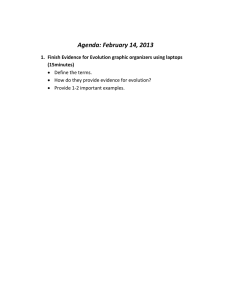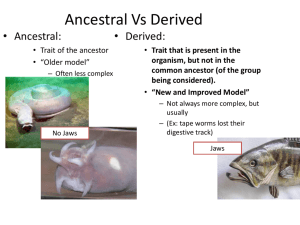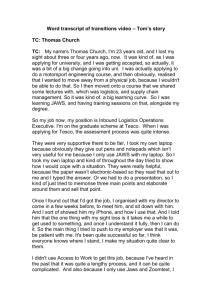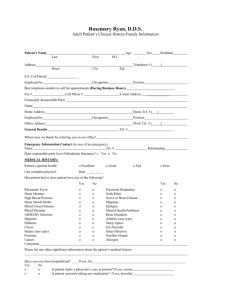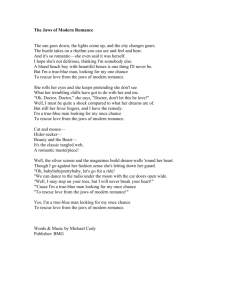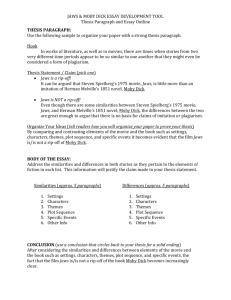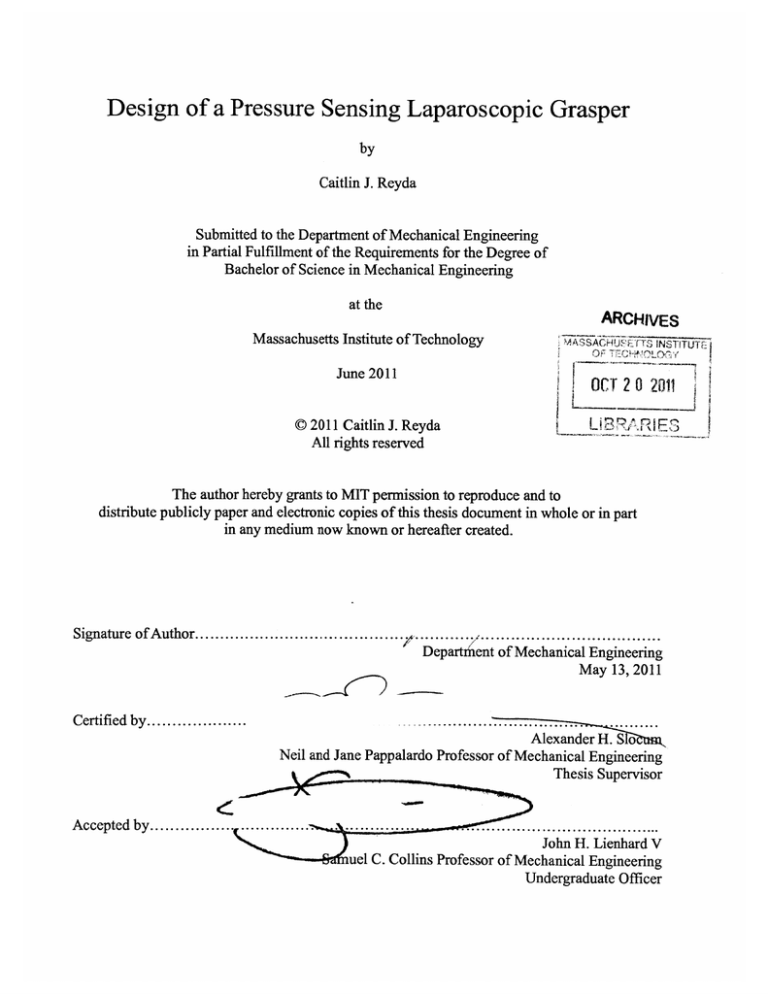
Design of a Pressure Sensing Laparoscopic Grasper
by
Caitlin J. Reyda
Submitted to the Department of Mechanical Engineering
in Partial Fulfillment of the Requirements for the Degree of
Bachelor of Science in Mechanical Engineering
at the
ARCHIVES
Massachusetts Institute of Technology
%AASSACH!Js{.F--070 INSTITUTE
Of7
TE7,CHoOG
1_
June 2011
w
OCT 2 0 2011
0 2011 Caitlin J. Reyda,
All rights reserved
L 072 RA R"
",IES
The author hereby grants to MIT permission to reproduce and to
distribute publicly paper and electronic copies of this thesis document in whole or in part
in any medium now known or hereafter created.
Signature of Author..........................................
C ertified by ....................
A ccepted by .................
........... ....................................
Departinent of Mechanical Engineering
May 13, 2011
.......................
--. ..
Alexander H.
Neil and Jane Pappalardo Professor of Mechanical Engineering
Thesis Supervisor
...............
. ..............
.................................
John H. Lienhard V
uel C. Collins Professor of Mechanical Engineering
Undergraduate Officer
Design of a Pressure Sensing Laparoscopic Grasper
by
Caitlin J. Reyda
Submitted to the Department of Mechanical Engineering
on May 13, 2011 in Partial Fulfillment of the
Requirements for the Degree of Bachelor of Science in
Mechanical Engineering
ABSTRACT
With smaller incisions, laparoscopic, or minimally invasive, surgery is considered safer
for patients than open surgery. However, the safety of current laparoscopic grasping instruments
can still be improved. Current devices provide surgeons with limited tactile feedback, and the
current alligator-style jaws create pinch points that can lead to torn or damaged tissue.
Additionally, the angled jaws can result in excessive grasping forces, due to the uneven pressure
distribution along the jaws, or slippage when grasping larger organs. Tissue trauma, in the form
of mechanical injury (crushing), ischemia (cut off blood supply), or perforation, can occur. A
new design uses a symmetric, 10-bar linkage to keep the grasping jaws parallel, creating a
uniform pressure distribution along the length of the jaws. A pressure sensor, located near the
trigger in the handle, can detect when the grasper jaws are applying too much force on an object.
When the force is above a given threshold, a vibration motor in the handle activates, warning the
surgeon. This improved tactile feedback can help surgeons control pressures applied during
grasping. The grasper design is further enhanced through an ergonomic pistol-grip handle, which
also includes a turning wheel to rotate the grasper and a locking mechanism to fix the jaws in
place. A working lx scale prototype was built to verify the feasibility of the design.
Thesis Supervisor: Alexander H. Slocum
Title: Neil and Jane Pappalardo Professor of Mechanical Engineering
4
ACKNOWLEDGEMENTS
I would like to thank Professor Alexander Slocum for his guidance this past year and for
this project opportunity. I would like to thank Dr. Khashayar Vakili from the Children's
Hospital Boston for bringing my team this design challenge and for giving us feedback. I would
also like to thank Nikolai Begg, Nevan Hanumara, and Dr. Julio Guerrero for their valuable
advice throughout the design process and Benjamin Peters and James Penn for their help
building prototypes. Most of all, I would like to thank Mattias Flander, Toomas Sepp, and James
White, for being dedicated team members this past semester. I wouldn't have gotten this far
without them. This project was made possible by funding from the Center for Integration of
Medicine and Innovative Technology and the rest of the 2.752 course sponsors: Ximedica,
Boston Scientific, Intuitive Surgical, Disney, Timken, and Bluefin Robotics.
TABLE OF CONTENTS
Abstract........................................................................................................................................................3
Acknowledgem ents .....................................................................................................................................
5
Table of Contents ........................................................................................................................................
6
List of Figures..............................................................................................................................................8
Chapter 1: Introduction .............................................................................................................................
9
1.1
M otivation.....................................................................................................................................9
1.2
Background and Prior Art.....................................................................................................
9
1.2.1
Current Instrum ents........................................................................................................
9
1.2.2
Force Feedback Designs .................................................................................................
10
1.2.3
Distributed Force Designs...............................................................................................
11
1.2.4
First Prototype.....................................................................................................................12
Chapter 2: Functional Requirem ents and Concepts...........................................................................
2.1
Introduction.................................................................................................................................13
2.2
Grasping......................................................................................................................................13
2.2.1
Functional Requirements .................................................................................................
2.2.2
Concepts..............................................................................................................................14
13
13
Tactile Feedback .........................................................................................................................
15
2.3.1
Functional Requirem ents .................................................................................................
15
2.3.2
Concepts..............................................................................................................................15
2.3
User Interface: H andle Ergonom ics........................................................................................
16
2.4.1
Functional Requirem ents .................................................................................................
16
2.4.2
Concepts..............................................................................................................................16
2.4
2.5
User Interface: Trigger................................................................................................................18
2.5.1
Functional Requirements .................................................................................................
2.5.2
Concepts..............................................................................................................................18
2.6
User Interface: Turning W heel ..............................................................................................
2.6.1
Functional Requirem ents .................................................................................................
2.6.2
Concepts..............................................................................................................................19
2.7
User Interface: Locking M echanism ......................................................................................
18
19
19
19
6
2.7.1
Functional Requirements.................................................................................................
2.7.2
Concepts..............................................................................................................................19
Chapter 3: Design and Fabrication ......................................................................................................
3.1
Grasping ......................................................................................................................................
19
21
21
3.1.1
Kinem atics ..........................................................................................................................
21
3.1.2
Force Analysis ....................................................................................................................
21
3.1.3
M aterial Selection ...............................................................................................................
22
3.1.4
Fabrication and Assembly...............................................................................................
23
3.2
Sensing........................................................................................................................................23
3.3
User Interface..............................................................................................................................25
3.3.1
Handle Ergonomics.............................................................................................................25
3.3.2
Trigger.................................................................................................................................25
3.3.3
Turning W heel ....................................................................................................................
26
3.3.4
Loc ng M echanism ............................................................................................................
27
Chapter 4: Results.....................................................................................................................................28
4.1
Introduction.................................................................................................................................28
4.2
Grasping......................................................................................................................................28
4.3
Sensing........................................................................................................................................29
4.4
User Interface..............................................................................................................................30
Chapter 5: Conclusion..............................................................................................................................32
5.1
Summary.....................................................................................................................................32
5.2
Future W ork................................................................................................................................32
References..................................................................................................................................................34
Appendix: Closed-Form M odel...............................................................................................................35
LIST OF FIGURES
Figure 1: Uneven pressure on current grasper jaws..................................................................
Figure 2: Scissor grip handle design of current graspers...........................................................
Figure 3: 2x prototype of new grasper......................................................................................
Figure 4: First grasper prototype, all links...............................................................................
Figure 5: Second grasper design, all flexures ...........................................................................
Figure 6: New grasper design, links and living hinges.............................................................
Figure 7: Slim pistol grip handle concept.....................................................................................
Figure 8: Thicker pistol grip handle concept.............................................................................
Figure 9: Rounded pistol grip handle concept...........................................................................
Figure 10: Caulking gun locking mechanism concept..................................................................
Figure 11: Threaded lever locking mechanism concept. ..............................................................
Figure 12: Ratio of forces in links to force applied at tip ........................................................
Figure 13: New grasper prototype. ............................................................................................
Figure 14: Electronics layout in handle ....................................................................................
Figure 15: Electronics in new prototype....................................................................................
Figure 16: New ergonomic handle prototype. ..........................................................................
Figure 17: New trigger design. ................................................................................................
Figure 18: Trigger pivot cavity ..................................................................................................
Figure 19: Turning wheel.................................................
Figure 20: Locking mechanism. ................................................................................................
Figure 21: Full 1x scale prototype of new design....................................................................
Figure 22: Grasper pinching mock tissue. ................................................................................
Figure 23: Compliance in grasper jaws. ..................................................................................
Figure 24: Grasping with pressure sensing ................................................................................
Figure 25: Ignoring pressure warning......................................................................................
10
10
12
14
14
15
17
17
18
20
20
22
23
24
24
25
26
26
27
27
28
29
29
30
30
8
CHAPTER 1
INTRODUCTION
1.1
Motivation
Dexterity is critical for surgeons to perform surgery safely and effectively. In
laparoscopic surgery, the ability for surgeons to manipulate tissue is limited by the grasping
ability and tactile feedback of their instruments. Tissue damage caused by excessive clamping
forces during surgery is common, due to the geometries of current grasper jaws. Surgeons also
have difficulty feeling how much force they are applying at the grasper tip. A new design can
both improve the geometry of the grasper jaws and incorporate tactile feedback to create a safer,
easier-to-use laparoscopic grasper. Additionally, surgeons who use current graspers for extended
periods of time are often subject to hand strain injuries due to poor handle design. A more
ergonomic handle design can relieve the strain on muscles during surgery and prevent nerve
damage.
1.2
1.2.1
Background and Prior Art
Current Instruments
Current graspers have angled jaws that cause an unequal pressure distribution along their
length, seen in Figure 1.1. Tissue grasped in the region closer to the joint will inevitably
experience a higher pressure than tissue grasped near the tip. On the other hand, laparoscopic
graspers are meant to grasp tissue. Since slippage can occur with insufficient pressure, surgeons
often result to grabbing the tissue with higher forces than they need, which can cause damage.
Another problem with current graspers is that they tend to push tissue out of the jaws as they
close, due to the angle. This can make grasping even more difficult, and tissue can be damaged
from repeated attempts at grasping it.
Figure 1: Uneven pressure on current grasper jaws.
Current graspers also use a scissor grip, shown below in Figure 1.2. This design makes it
difficult for surgeons to hold the grasper jaws steady while they open and close the handle.
Surgeons end up clenching the handle tighter to keep it steady, which leads to increased muscle
strain and nerve damage over long periods of time.
Figure 2: Scissor grip handle design of current graspers.
1.2.2
Force Feedback Designs
Force feedback is important for grasp control and safety. In a study of 386 European
laparoscopic surgeons by Delft Institute of Technology, 79% felt it was necessary to have a "new
laparoscopic grasper with augmented feedback" while 77% wanted "tactile feedback as
indication of level of pinch force" [1]. When augmented force feedback was provided, a third of
the subjects, consisting of both experienced and novice surgeons, became dependent on it for
laparoscopic grasping [2].
Several attempts have been made to incorporate force feedback into laparoscopic
graspers. Designs with vibrotactile grips, in which the handle vibrates at certain grasper
pressures, have been employed and shown to be useful in aiding safe grasping and education of
novice surgeons [2]. Another form of tactile feedback used an extended lever mechanism
possessing a high mechanical efficiency of up to 90% [3]. This allowed subjects to "feel" the
stiffness of the object being grasped. Unfortunately, subjects found it difficult to exert constant
force on tissue, and the actual mechanism was too large and impractical for an actual
laparoscopic instrument. Finally, a grasper was designed with master and slave components at
the handle and jaws, respectively, possessing separate motors and controllers. By manipulating
finger loops at the handle, the position of the jaws could be controlled. Forces experienced at the
jaws were then reflected back to the loops [4]. This mechanism required a relatively large
amount of circuitry and electronics.
1.2.3
Distributed Force Designs
Other attempts at re-designing laparoscopic graspers have focused on reducing the peak
pressures experienced on the tissue being grasped due to an uneven pressure distribution. Some
mechanisms consisting of parallel jaws have been designed and patented [5, 6]. In one version, a
3-fingered parallel mechanism for specialized grasping of large organs similar to the linkage
proposed in this paper was described [6]. Another grasper was designed in which grasper jaws
were replaced with jointed, finger-like jaws. These jaws reflected the movement of fingers at the
handle, which had finger-loops. This allowed bowel to be grasped and suspended from curved
"fingers", as in open surgery [7]. Vacuum suction has also been successfully experimented with
for reducing tissue trauma, in which the grasper jaws are replaced by a suction device [8].
Finally, peak pressures at the grasper jaws have been shown to be somewhat eliminated by the
use of compliant tip made of silicon [9].
1.2.4
First Prototype
A 2x scale prototype was built last semester (Figure 1.3). It proved the feasibility of
grasping with parallel jaws, sensing pressure, and providing tactile feedback. The 10-bar parallel
linkage design of the grasper worked well to distribute forces evenly, but it occasionally locked
up when grasping smaller objects. A pressure sensor, located at the grasper tip, worked well to
detect grasping forces, but its location required wires running through the links, making it
difficult to assemble. The handle was significantly more ergonomic than the commercial scissor
grip handle, but it was still difficult to maneuver. This paper covers the transition from this 2x
scale prototype to a lx scale model and the additional features that have been added or changed
since then.
Figure 3: 2x prototype of new grasper.
CHAPTER 2
FUNCTIONAL REQUIREMENTS AND
CONCEPTS
2.1
Introduction
Since the new laparoscopic grasper is designed to replace current graspers, it must, at the
very least, have all the same functions. The grasper should exert enough force to be able to grab
and move tissue with minimal risk of tissue slippage. At the same time, it should minimize the
risk of applying too much pressure while grasping to avoid tissue damage. The grasper should be
at least as maneuverable as the current grasper, and it needs to fit through a standard 5mm trocar.
It should also be designed for both the right and the left hand, since surgeons use both hands
during surgery. It must be as safe as possible for both the patient and the surgeon, so no
electronic components should be exposed. Finally, the device should be similarly priced to
current graspers.
To address the problems with commercial graspers, the new device must improve on
three main areas: grasper jaws, tactile feedback, and user interface. The following sections cover
possible concepts for how these problems can be addressed and how current functions can be
incorporated.
2.2
Grasping
2.2.1
Functional Requirements
Current grasping jaws do not apply uniform pressure. Because they are designed with
angled jaws in an alligator-style grip, they apply pressure unevenly along their length. More
pressure is applied closer to the joint, where there is a pinch-point that can bruise or even tear
tissue. The jaws also tend to push objects outwards when they close, making it difficult to grab
large, slippery objects such as organs. The new grasper should distribute pressure evenly across
its jaws.
2.2.2
Concepts
The previous prototype in Figure 2.1 used four-bar-linkages to keep the grasper jaws
parallel with additional links to open and close the grasper. This kept pressure distributed evenly
across the jaws. However, since the holes of the joints must be slightly larger than the pins, the
tolerance accumulated until there was significant side-to-side slack. Also, the previous prototype
was made 2x scale. The links and pins get extremely small for 1x scale and assembly becomes
increasingly difficult.
Figure 4: First grasper prototype, all links.
To eliminate the tolerance in the link joints and to make assembly easier, we considered
purely flexural designs. However, to fit through a 5mm trocar, the flexures had to be very thin.
This, combined with the large angular displacement required in the four-bar-linkage design
forced us to consider a new design. One of them is shown below in Figure 2.2. In this design, the
flexures are placed on the end so that they do not need to flex as much, but the parallel links end
up being too close together to function as four-bar-linkages. The flexures are also still too thin to
withstand the angular displacement.
Figure 5: Second grasper design, all flexures.
Since finding a purely flexural design was difficult, a hybrid flexure-link design, shown
below in Figure 2.3, was explored instead. Living hinges, a key design component of the new
grasper, were introduced. Living hinges are important to the new design because they can have
the flexibility of pin joints without the slack and can reduce the part count. This changes the
material of the grasper jaws from metal to plastic, but with the right material selection, the jaws
can still be stiff enough to grasp tissue effectively.
Figure 6: New grasper design, links and living hinges.
2.3
2.3.1
Tactile Feedback
Functional Requirements
Current graspers have limited tactile feedback. It is difficult for surgeons to feel how
much pressure they are applying at the grasper tip from their grip on the handle. To improve this,
the new design should incorporate sensing to determine the pressure at the jaws and provide
feedback for the doctor.
2.3.2
Concepts
A variety of sensors and sensor orientations were considered for measuring pressure. A
force sensor seemed to be the most appropriate for this application. It could either be placed
directly at the tip or somewhere in the handle. A force sensor at the tip would provide the most
accurate reading, but it would be difficult to run covered wires all the way from the tip to the
handle. A force sensor in the handle would keep all the electronics contained in one place and
isolated from the surgeon and patient, but it is more difficult to determine the tip force. Instead of
directly measuring pressure at the tip, the sensor would measure force in the shaft. This, along
with a potentiometer to measure the shaft displacement (and jaw position), could then be
converted into an estimated tip pressure. In addition, this measurement will be affected by noise
due to friction in the system.
The main form of feedback considered for the new grasper design was vibration through
the handle. The previous prototype included an LED in addition to the vibration, which was
useful for testing but not in practice. Surgeons look at the camera feed for most of their surgeries
and cannot pay attention to the light on their grasper handle.
2.4
2.4.1
User Interface: Handle Ergonomics
Functional Requirements
The most common commercial graspers use scissor-grip handles, which have poor
ergonomics. These designs make it difficult for surgeons to hold the grasper tip steady while they
move their fingers to open and close the jaws. Additionally, surgeons end up clenching the
handle tighter in order to keep the grasper steady. This leads to increased muscle strain and nerve
damage in their fingers. The new handle should encourage a natural grip to make long surgeries
safer and more comfortable for surgeons.
2.4.2
Concepts
The previous prototype design has a thick, angled handle seen in Figure 1.3 that can be
gripped with the palm of a surgeon's hand. This provides a solid base to prevent unwanted
motion at the grasper tip. The handle ergonomics, however, still have room for improvement. A
pistol grip, instead, encourages a more natural hand position and is familiar to many people.
The first handle concept for the new design, shown in Figure 2.4, used a pistol grip
outline. It was slim like the commercial designs to keep the handle lightweight and more
compact for easier packaging. A sample handle was 3D printed for user testing. People liked the
new contours but complained about the lack of thickness. The handle put pressure at the base of
the palm and did not allow a solid grasp.
Figure 7: Slim pistol grip handle concept.
The second handle concept, shown in Figure 2.5, had the same pistol-grip outline but
was thicker for added comfort. Another sample handle was 3D-printed for this design. Most
people liked the general shape but complained that the edges were too sharp. People with larger
hands also suggested making the handle slightly longer.
Figure 8: Thicker pistol grip handle concept.
The third and final handle concept, shown in Figure 2.6, has a new, though similar,
pistol-grip outline with rounder edges and a longer grip. The base of the grip is also slightly
tapered outwards to accommodate users with larger hands.
Figure 9: Rounded pistol grip handle concept.
2.5 User Interface: Trigger
2.5.1
Functional Requirements
A trigger is needed for a pistol-style handle in order to open and close the grasper jaws.
The trigger should be designed for two-finger use, since one finger might get fatigued during
several-hour-long surgeries. It should also be ergonomic and easy to operate.
2.5.2
Concepts
The first trigger design, shown above in Figure 2.4, was modeled after a standard pistol.
However, when people tested the sample handle, they often held it with one finger, like a
handgun, instead of with two. Some people also complained that the trigger stuck out too far.
The second and third trigger designs, shown above in Figures 2.5 and 2.6, use an
extended loop. The extra space in these designs encourages users to hold the triggers with both
fingers. As an added benefit, the loops enable surgeons to push forward to force the grasper
open. While a return spring on the shaft will usually keep the grasper open in its neutral position,
the ability to force the grasper open can be useful. If surgeons want to push two organs apart but
the return spring is not strong enough to keep the grasper open, then the surgeon can push on the
trigger to open the jaws.
2.6 User Interface: Turning Wheel
2.6.1
Functional Requirements
A turning wheel is essential for surgeons to be able to rotate the grasper jaws to their
desired orientation. They typically need to do this in the middle of surgery while the grasper is
inside the body. Since their other hand is often holding another instrument, they must be able to
rotate the jaws with the same hand that is holding the grasper.
2.6.2
Concepts
Commercial graspers accomplish this requirement effectively by adding a wheel to the tip
of the handle that connects to the outer sheath, shown in Figure 1.2. The surgeon can then rotate
the jaws, which are connected to the end of the outer sheath, by rotating the wheel with their
index finger. This can be done without removing any other fingers from the handle or adjusting
the grip. Because this method is effective, a similar method is implemented in the new design.
2.7
2.7.1
User Interface: Locking Mechanism
Functional Requirements
Surgeons sometimes need to lock the grasper jaws at certain positions during surgery to
hold tissue for extended periods of time. Some also prefer to lock the graspers in the closed
position before inserting and removing the device from the trocar. The new grasper design
should have a mechanism to lock the jaws at any position. Surgeons should be able to activate
and deactivate this mechanism with one hand while holding the handle and should be able to do
it with either hand.
2.7.2
Concepts
Commercial graspers use a ratchet mechanism to fulfill this requirement. The ratchet can
be engaged to close the jaws in discrete steps or disengaged to allow the jaws to move freely.
Since the new handle would be larger than the commercial grasper, new ratchet designs were
explored for different locations.
However, many doctors do not need the ratchet feature. A simple on/off lock can
accomplish the same functional requirements. An on/off lock can also be easier to use than a
ratchet. Since the handle can move freely before it is locked, it is easier to adjust the jaws to the
correct position. The first lock design was inspired by the advancing mechanism on caulking
guns. The design, shown below in Figure 2.7, relies on a plate with a circular hole clamping
down on the shaft as it turns. However, a quick test showed that the plate would need to twist
hard enough to dig into the shaft in order to prevent movement.
Figure 10: Caulking gun locking mechanism concept.
A different locking mechanism, seen in Figure 2.8, uses a partially threaded collar and a
partially threaded lever. When the lever is in the unlocked position, the shaft is able to slide
freely. When the lever is rotated, the threads engage and lock the shaft in its current position.
Also, there are two sides to the lever, so that it can be accessed from either side of the handle. A
quick prototype proved the feasibility of this mechanism, so it is implemented in the new design.
Figure 11: Threaded lever locking mechanism concept.
CHAPTER 3
DESIGN AND FABRICATION
3.1
Grasping
A 10-bar linkage was designed and implemented in the first prototype. This design
successfully kept the grasping jaws parallel, distributing the forces evenly. However, the
unavoidable clearance of pins (and pin holes) led to an accumulation of error in actual link
lengths. Because the front parallel links are put under tension and the back parallel links are put
under compression, the jaws are able to invert if they are grasping a small enough object. This
causes the jaws to lock up, which can be extremely dangerous during surgery. The kinematics of
the jaws was analyzed to find a solution to this problem.
3.1.1
Kinematics
Mattias Flander and Toomas Sepp found closed-form equations for the 10-bar linkage
design, which can be found in the Appendix. These equations showed that for a given decrease in
length of the front links, the jaws will never invert. The difference in length is equal to the
combined tolerances of the pins and pin holes. This means that the jaws will never be completely
parallel (they will be closer towards the tip), but the angle should be small enough that the forces
remain evenly distributed.
3.1.2
Force Analysis
Using the closed-form equations from the kinematics, the forces on each link and the
main shaft could be found. The ratio of forces in the links to the force applied at the tip can
found in Figure 12 with respect to how far the jaws are open. This shows that the forces in the
links and shaft are much higher when the jaws are almost closed, which makes sense because
there is almost no mechanical advantage compared to when the jaws are open.
20
-- Link 1
--- Link 2
'.
6
Link 3
'.-e-
12
Shaft
-
8
8 00
0L
4
e000dOWE!!
12
0.0
0.2
0.4
0.6
0.8
1.0
Tip Separation (in)
Figure 12: Ratio of forces in links to force applied at tip.
3.1.3
Material Selection
Since the new design uses living hinges to reduce backlash (from links) and part count,
the pieces with the hinges must be made out of plastic instead of metal. Plastics can be medical
grade and the jaws only need to be robust enough to survive one surgery, since laparoscopic
graspers are often disposable. The only concern with using plastic is that the jaws might not be
stiff enough to grasp with the required force. This can be a good thing, since the jaws will act as
a built-in safety to prevent excessive jaw forces. Further research needs to be done to choose an
ideal material.
Polypropylene is the most suitable material for living hinges because it is a very adaptive
and ductile material [10]. However, these properties also make it extremely difficult to machine.
Nylon was chosen for the grasping jaws instead, because it is much easier to machine but has
enough elasticity to be a living hinge. The final parts can be injection molded out of
polypropylene for better hinge properties. With plastic already being used for the hinges, it might
be possible to mold a sensor directly into the jaws in the future.
3.1.4
Fabrication and Assembly
The new grasper prototype is shown below in Figure 13. The grasper jaws were hand-
machined out of nylon and the shaft and links were hand-machined from steel. It took some
patience to assemble the final grasper with its miniature pins, but it was still easier than expected.
The links are held in place with an application of super glue on either side.
Figure 13: New grasper prototype.
3.2
Sensing
For the new prototype, all of the electronics, including the pressure sensor, were placed in
the handle. To sense the force at the grasper jaws, a Tekscan Flexiforce pressure sensor was
placed behind the trigger, in-line with the shaft. The amount of force on the shaft correlates to
the amount of force at the jaws. However, there is a greater mechanical advantage in the grasper
when the jaws are fully open, compared to when they are nearly closed. It takes less force on the
shaft when the jaws are open to apply the same amount of force as when they are closed (seen in
Figure 12). To account for this, a potentiometer measuring the position of the grasper jaws was
installed in-line with the shaft. This also required the use of a programmable Atmel
ATTiny461V microcontroller for versatile feedback. James White assembled and programmed
the electronics, which are shown in Figures 14 and 15.
Potentiometer
Bushin for
Ssensing surnace
3V Photocell
baer
PCB
A
Teiforce
placement
Vibiation motrf
Figure 14: Electronics layout in handle.
Figure 15: Electronics in new prototype.
3.3
User Interface
The new grasper was designed with the same functions of the current graspers but with a
more ergonomic user interface. The new design is intended to keep the hand in a more natural
position to limit repetitive strain injury, and it allows the user to perform all necessary functions
with one hand.
3.3.1
Handle Ergonomics
The new prototype, seen in Figure 16, is modeled after a pistol grip. The edges are
rounded to make it more comfortable and the base is extended and tapered outwards to account
for different hand sizes. The user can reach the locking mechanism with their thumb and the
turning wheel with their index finger.
Figure 16: New ergonomic handle prototype.
3.3.2
Trigger
The trigger was designed to fit in line with the shaft as seen above in Figure 15, with the
shaft running through it. Since closing the grip of most commercial graspers causes the jaws the
close, it would be easier for surgeons to adapt to the new design if closing, or pulling, the trigger
also caused the jaws to close. This means that the pivot point needs to be placed above the shaft.
Also, the trigger needs to have a large enough range of motion, or throw, to be able to open the
grasper jaws wide enough but still be within the range of the user's grip. For the jaws to be fully
open (approximately 0.84"), the shaft needs to move 0.265". To prevent the grip from becoming
too large, the pivot point had to be raised higher.
In the final design in (Figure 17), a cam on either side of the trigger makes contact with
bushings that cause the shaft to move either forwards or backwards. Ideally, the cam would
allow for a rolling contact between the two surfaces, but in this design, the two surfaces just slide
against each other.
Figure 17: New trigger design.
The trigger pivot was made out of a 0.0625" pin to make it stronger. However, the initial
pin cavity was too weak (Figure 18: left). This broke under normal use of the trigger, so it was
made wider with added fillets (Figure 18: right).
Figure 18: Trigger pivot cavity.
3.3.3
Turning Wheel
A wheel, shown in Figure 19 below, was designed to be placed at the front of the handle.
It has a slot in the center corresponding to two flat surfaces on the outer sheath and ridges to
provide grip for easier turning. The wheel was 3D printed for the new prototype. It can be
injection molded in the future.
Figure 19: Turning wheel.
3.3.4
Locking Mechanism
The lever for the locking mechanism of the new prototype, seen below, was laser cut out
of acrylic sheet, threaded, and then milled down. The raised bosses on either side of the lever
were used to constrain the lock. The bosses were sandwiched between bearing seats on the
handle, allowing the lever to spin freely while remaining in the correct alignment.
Figure 20: Locking mechanism.
The threaded collar was made from a %"-28 steel bolt that was drilled through with flats
milled into it. Besides allowing the threads to disengage during the unlocked state, the flats also
aligned with hard stops on the inner handle surfaces. This prevented the collar from rotating with
the lever but still allowed the inner shaft to slide freely. Since the shaft must have been able to
rotate relative to the threaded collar but slide with it, e-clips were placed on either side.
CHAPTER 4
RESULTS
4.1
Introduction
A fully functional lx scale prototype of the pressure sensing laparoscopic grasper was
built and can be seen in Figure 21. The grasper has all the same features of current graspers,
along with added pressure sensing, feedback, and parallel grasping jaws. This prototype is also
able to fit through a 5mm trocar.
Figure 21: Full 1x scale prototype of new design.
4.2
Grasping
The grasping jaws can pick up and manipulate small objects very easily. The jaws are
limited to picking up objects that are smaller than 0.8" thick, but this is comparable to current
grasping jaws. Figure 22 shows the jaws squeezing a compliant tube that simulates a section of
bowel.
Figure 22: Grasper pinching mock tissue.
Since the jaws are made out of plastic, they are not as rigid as the current jaws that are
made out of metal. This makes it difficult to clamp with a higher force or pick up heavier items.
Figure 23 shows the compliance of the jaws as more force is applied. This can be solved with a
stronger plastic or with metal inserts in the jaw region. The grasper is also weak under torsion. It
needs to be strengthened so that it can be able to twist tissue if needed.
Figure 23: Compliance in grasper jaws.
4.3
Sensing
The electronics for pressure sensing and tactile feedback were successfully integrated in
the handle of the new grasper prototype. The sensitivity of the device can be set to a particular
threshold, and vibration in the handle can warn the user if they have applied too much force at
the tip. In Figure 24, the grasper is shown squeezing a banana slice (to represent tissue), which
29
activates the vibrator before any damage is done. In the next image (Figure 25), the vibration
warning is ignored and the banana (or tissue) is harmed.
Figure 24: Grasping with pressure sensing.
Figure 25: Ignoring pressure warning.
4.4 User Interface
The turning wheel rotates the grasper jaws effectively, but it requires the use of an extra
hand. The wheel is slightly too far to reach with the index finger and the ridges are slightly too
shallow to grip. Moving the wheel back and adding fewer deeper ridges would be more effective.
Also, the turning wheel is only designed to turn the outer sheath. This means that the inner shaft
only spins due to the torque from the grasper jaws. If the inner shaft gets caught while the outer
sheath is turning, for some reason, then the jaws will twist and possibly break. It would help to
fix the inner shaft to the outer sheath at a point near the handle so they do not rely on the grasper
jaws and links for torque.
The locking mechanism works very effectively once the threads of the collar were
engaged, but it sometimes takes a while to get the threads to mesh. The lock also works when the
lever is only half-rotated and the threads are only partially engaged. This might not be strong
enough and could possibly break during use. Also, the current lever is made with acrylic, while
the collar is steel. This works for now, but they should both be made out of metal in the future.
This will increase the overall strength and prevent one set of threads from stripping the other.
CHAPTER 5
CONCLUSION
5.1
Summary
The purpose of this thesis was to design and fabricate a laparoscopic grasper that can
make minimally invasive surgery safer for both patients and surgeons. A novel laparoscopic
grasper with parallel grasping jaws, pressure detection, tactile feedback, and an ergonomic user
interface was created. This device has the same capabilities of current graspers, including a
turning wheel and locking mechanism, and it can fit through a standard 5mm trocar. In
preliminary testing, the grasper has been shown to warn users (through vibration) when they are
applying too much pressure at the tip. This can significantly reduce the risk of bruised or torn
tissue caused by excessive grasping forces during surgery. This design can also be adapted for
other types of laparoscopic graspers.
5.2
Future Work
The feasibility of the grasper has been shown, but there is still room for improvement.
Alternative materials need to be researched for the grasper jaws. They need to be stiff enough to
grasp organs with sufficient force but compliant enough for living hinges. If the jaws are made
out of plastic, then a force sensor can possibly be molded directly into the tip. This would greatly
reduce the noise caused by friction in the shaft and links. It is also possible that the grasper can
be made entirely out of living hinges to eliminate the need for links.
The handle design for the grasper also needs to be refined. The handle is much more
ergonomic than previous grasper handles, but more contours can make it even more comfortable
to hold. The placement of the turning wheel, locking mechanism, and trigger also need to be
adjusted to fit a larger range of hands. This can be improved through extensive user testing and
feedback.
Testing-both on a test bench and on animal tissue-needs to be done to quantify the
performance of the new prototype. Mechanical tests can provide information on the accuracy and
limitations of the device, while live tissue testing can provide insight on possible weaknesses
with the design. Additionally, user feedback from multiple surgeons would be extremely
valuable.
Finally, all of the parts need to be redesigned for manufacturability. The parts for the
prototype were either machined or 3D printed, which are unacceptable processes for final
production. Extrusion, stamping, and injection molding are all feasible processes for the parts in
this design.
REFERENCES
[1]
Westebring-van der Putten, E.P., et al., The opinion and experience of surgeons with
laparoscopicbowel grasperhaptics.Journal of Biomedical Science and Engineering,
2010. 3(4): p. 422-429.
[2]
Westebring-van der Putten, E.P., et al., The effect of augmentedfeedbackon graspforce
in laparoscopicgrasp control. IEEE Transactions on Haptics, 2010. 3(4): p. 280-291.
[3]
Heijnsdijk, E., et al., The influence offorce feedback and visualfeedback in grasping
tissue laparoscopically.Surgical Endoscopy, 2004. 18(6): p. 980-985.
[4]
MacFarlane, M., et al., Force-feedback grasperhelps restore sense of touch in minimally
invasive surgery. Journal of Gastrointestinal Surgery, 1999. 3(3): p. 278-285.
[5]
Griffiths, J.R., Laparoscopicinstrumentwith parallelactuatedjaws. U.S.P. Office,
Editor. 2001: United States.
[6]
Mirbagheri, A. and F. Farahmand. Design and analysis of an actuatedendoscopic
grasperfor manipulationof large body organs.Engineering in Medicine and Biology
Society (EMBC), 2010 Annual International Conference of the IEEE. 2010.
[7]
Frank, T.G. and A. Cuschieri, Prehensileatraumaticgrasperwith intuitive ergonomics.
Surgical Endoscopy, 1997. 11(10): p. 1036-1039.
[8]
Vonck, D., et al., Vacuum grasping as a manipulationtechniquefor minimally invasive
surgery. Surgical Endoscopy. 24(10): p. 2418-2423.
[9]
Marucci, D.D., et al., A compliant tip reduces the peak pressureof laparoscopic
graspers.ANZ Journal of Surgery, 2002.72(7): p. 476-478.
[10]
Erhard, G., Designing with Plastics. 2006, Cincinnati: Hanser Gardner.
APPENDIX
CLOSED-FORM MODEL
Figure 26: Critical dimensions and forces of grasper.
Figure 27: Values to quantify the performance of the grasper.
Dpin
Figure 28: Difference in pin diameter and pin hole size.
: Al ,
= i
11
1
11,effective
1
2::
2=
A , Dpin
+ Al + A Dpin
Ai
12,effective = 12 -
Dpin
- A
+
- A
A DIink
Diink
a=
+ l -
jleff
2 1
1,eff16COS (180 -
2,eff + a2 -
02=acosa
y= asin
Ishaft
=
21
13
l3 CoS Y
a
2,eff
12,effsinO2
+acos
- (Diink-
Dpin)
14
-
- |2,effCOS 0 2
FtLi(L + 15)
F5 sinO1
1 ) + FEip
Fj1 (cosO1sinO2 - sinG
siny cos0 2 - cosy sinG2
F13
F2t -
F1 sin 1 - F13 siny
sinG2
Fshaft = F 1cosG1 + F12 CosG 2
a
(in11,ef5sinGI
Is
\si
= (Lti, +
-
1
2 ,effSinG2
I5) sina
= 2 (l2,effsin2 -
17
cosa
+
01)
(a 2
DIink
+ (Dink - Dpin)
81
01
A
A Dpin ,
Dpin
6
21
2l 6 a
eff
=
Diink
L ADink

